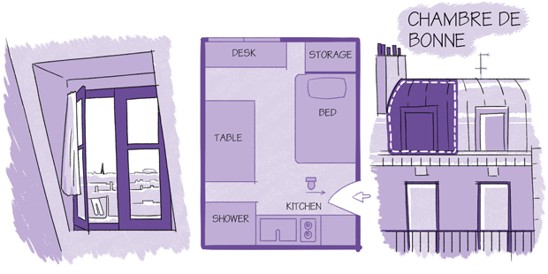Before Paris’s Modern-Day Studios, There Were Chambres de Bonne
Tiny upper-floor “maids’ rooms” have helped drive down local assumptions about exactly how small a livable home can be.
Editor’s note: This is the fourth article in a series on the home designs that define four European cities: London, Berlin, Amsterdam, and Paris. Read the collection here.
Many of Paris’ grandest buildings hide a secret. The main facades of the city’s avenues may charm with their wrought-iron balconies and honey limestone. Inside, they may contain grand, high-ceilinged apartments on their main floors. Under the roofs and up the back staircases, however, it’s a different story. These buildings, largely constructed as part of Baron Haussmann’s mid-19th century remodeling of the city, have, despite their grandeur, long housed some of the city’s poorest residents.
Called Chambres de Bonne—“maids’ rooms”—these tiny bedsits initially intended for domestics are packed into Paris’ garrets and still number more than 100,000 across the city. Usually built without bathrooms or running water, the floorspace of these units can be as small as 85 square feet, often making them legally unrentable today. The construction of such spaces may be long passed—and most Parisians live in more spacious conditions—but Paris’ Chambres de Bonne have still done their bit to shape the city’s contemporary living culture. They have helped to combine different classes under a single roof, by stacking poor residents above wealthy—and have helped to drive down local assumptions about exactly how small a living unit can be.

Given their small size, it might seem incredible that when Paris’ Chambres de Bonne first surfaced as an urban phenomenon they actually represented an improvement for many. Until the mid-19th century, it was common for French domestic servants to sleep on mattresses wherever space could be found in their employers’ homes. As wealthier families moved into apartments in Haussmann’s new buildings, however, the domestic servants they needed were finally given their own (tiny) spaces: right under the roof dormers accessed by a service staircase. With only shared water pumps, these rooms were often freezing in winter, but they at least offered their tenants some privacy.
The Parisian public has nonetheless always been aware that the rooms’ conditions were bleak. As far back as Émile Zola’s 1882 novel Pot-Bouille, writers have been deploring them and, even as their original servant tenants were replaced with other low-income groups, they developed a reputation as louche, shady places whose seclusion placed them outside regular social control. As sociologist David Lepoutre put it in 2010:
This presence of a poor population on the sixth floor … perpetuates in renewed forms an old vertical urban segregation. It induces practices that make the top floor a place of weak social control where marginal lifestyles and an illegal economy can develop: midnight move-outs, un-authorized sublets, squats, wild electrical connections, warehouses of furniture and objects of all kinds in the corridors.
The city has tried to regulate the rooms for over a century. As early as 1904, the city banned maids’ rooms of less that 8 square meters (86 square feet) from being rented, a limit extended in 2002 to a princely minimum of nine square meters (97 square feet). While maids’ rooms can be more than double that size, that 9-square-meter legal threshold still meant many were left legally unrentable. As of 2016, up to 85 percent of Paris’ 113,000 maids’ rooms were either empty or let illegally.
That doesn’t mean that the rooms have necessarily retired from the scene. Some have a second life as Airbnbs for guests who are happy to trade cramped conditions for a good price and location. And shadowing North American design publications’ obsession with tiny homes, Parisian media commonly celebrate revamped maids’ rooms, made habitable by ingenious fold-down furniture and inventive storage.

Meanwhile the city is trying to bring them back into the fold. The municipality adopted a policy in 2016 of combining maids’ rooms to make small public apartments. So far, plans have been very modest—the city has set itself the target of creating just 500 new public homes from combining attic rooms. But the location of many of these units in prosperous western Paris will help promote the city’s goal of encouraging more public housing in wealthier areas.
While maids’ rooms are steadily being converted, the shadow they cast still shapes the Parisian view in a city where people still tend to live in small spaces. As of 2014, the average size of a flat within Paris’ Peripherique beltway was just 43 square meters (463 square feet)—minuscule compared to 70.4 square meters in Berlin and 74 square meters in Amsterdam. The average Parisian would no doubt balk at squeezing into a single attic studio, but in a city whose cultural image has, from La Bohème to Ratatouille, celebrated both the squalor and freedom of garret living, the maids’ rooms still shape expectations. A Parisian might find their tiny one-bedroom apartment claustrophobic but, they may reason, at least they aren’t squeezed tightly into an old servant’s room under the eaves.
